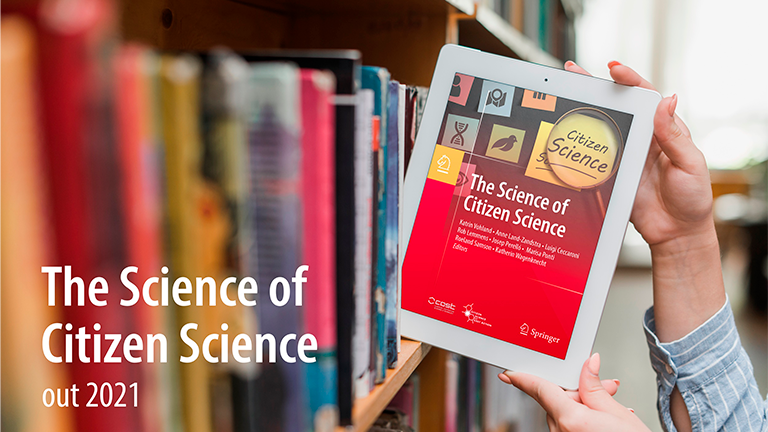
@SPOTTERON
The book covers the whole spectrum of citizen science theory and practice in Europe, and was the result of a collaboration of over 100 authors from 24 countries, including the Cos4Cloud coordinator, Jaume Piera, a researcher at the ICM-CSIC and associated researcher at CREAF, Luigi Ceccaroni, innovation and strategic manager at Earthwatch Europe and part of Cos4Cloud, who was also one of the book’s lead editors. Several other Cos4Cloud team members also contributed: Sasha Woods from Earthwatch Europe, Tim Woods from ECSA, Rosa Arias from Science for Change, and Maria Daskolia from NKUA.
This work results from four years of intensive exchange within COST Action 15212, a European research network on citizen science, and provides an extensive overview of citizen science practices and scientific and societal outcomes in different disciplines.
“This is possibly the most important book on citizen science published to date and has the potential to significantly expand the use of citizen science by research communities around the world,” says Luigi Ceccaroni, who also co-authored several chapters of the book. “It’s been a great honour for my colleagues and me to contribute to it.”
A growing science in Europe
The publication is aimed at different groups of readers, from university students to researchers and citizen science organization members. But it is also a book for everyone interested in understanding what citizen science is. “They will find all the answers in there,” points out Maria Daskolia, associate professor at the NKUA, leader of the integration of citizen science in schools in the Cos4Cloud project, and one of the book’s co-authors.
The chapter ‘Citizen Science in Europe‘, to which Maria contributed, explains the citizen science landscape and evolution across Europe, including some recommendations on developing networks by utilizing the COST Action and EU-Citizen.Science as capacity-building platforms. Specifically, Maria was in charge of mapping and discussing how citizen science has evolved in Southeastern Europe and the Balkans, and selecting and presenting the examples of some countries and projects.
“Co-authoring this chapter was a highly creative and inspiring opportunity for me,” says Maria.
The book also mentions Natusfera, one of the citizen observatories that participates in Cos4Cloud, as a successful example of citizen science in Spain, and it highlights Cos4Cloud as an opportunity to address the open science challenges and integrate citizen science in the European Open Science Cloud (EOSC).
Citizen science guidelines: How to find the right one?
The chapter ‘Finding what you need: A guide to citizen science guidelines’ describes citizen science guidelines on themes such as specific concepts and methodologies, data management and project implementation, and aims to help users find the guideline they need. It also encompasses recommendations to consider when creating guidelines. Tim Woods, communications officer at ECSA and involved in the Cos4Cloud and PANELFIT projects, collaborated in this chapter.
Tim states that co-authoring this chapter was a learning experience: “I discovered a lot about the history of the field, such as the example of sailors contributing to ocean science way back in the nineteenth century”.
Tim also contributed to the ‘Communications and dissemination’ chapter, which explains successful strategies to engage participants and promote citizen science projects.
Towards a more sustainable future
Climate change, loss of biodiversity, and the growing inequities within and between society are central topics throughout the book. For example, the text discusses how citizens’ involvement in scientific endeavors could help solve these challenges.
One of the chapters, ‘Citizen science, health and environmental justice‘, reviews how citizen science research can address problems related to public health and the environment. “If someone has any questions about citizen science – what it is, how it can be used, why it is so powerful, but also what the potential limitations are – they will find the answer, or at least the beginnings of the answer, within this book,” says Sasha Woods, one of this chapter’s co-authors, a researcher for impact and innovation at Earthwatch Europe and dissemination leader in Cos4Cloud.
The Cos4Cloud coordinator, Jaume Piera, who was recently elected as part of the ECSA’s board of directors, co-authored with Luigi Ceccaroni the chapter ‘A conceptual model for participants and activities in citizen science’. This focuses on providing a common understanding and representation of citizen science projects, their participants, and their outcomes to enable seamless knowledge and citizen science data-sharing.
Everyone is welcome to download the book for free (it is open access) and explore citizen science in depth.
Cover Artwork: SPOTTERON Citizen Science | www.spotteron.net
@SPOTTERON

















